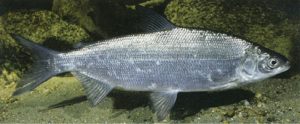Common name: Yellow perch

Scientific name: Perca flavescens (Perca means “dusky”; flavescens means “becoming gold colored”)
Appearance: Brown and yellow on the sides, green to olive around the head, yellow perch have spiky fins, forked tails, and long snouts.
Distribution: Yellow perch have been stocked extensively throughout North America’s lakes and waterways.
Spawning: Yellow perch begin spawning in April or early May when water temperatures reach 45-50ºF. Females will scatterstrings of more than 100,000randomly over vegetation, where they are fertilized by males. Perch do not guard their eggs, and many of their defenseless fry are devoured by walleyes, pickerel, bass, andpike. Those that survive take cover in shallow weedbeds, where they eat plankton and insect larvae, eventually moving on to small fish and other perch.
Fishermen can catch huge numbers of perch during their spawning runs, a practice encouraged by many biologists who regard overcrowding as the leading threat to perch populations.
Angling: Bottom feeders with a preference for cooler water, yellow perch can be found in deeper water during the day, moving into the shallows towards sundown. Perch school by size, and sometimes by gender, ih groups often numbering over a hundred fish. Because of this, fishermen looking for perch needn’t make more than a couple of casts in any given spot before moving on: if there’s one perch in an area, there’s at least a dozen more, and one of them’s bound to bite.
Yellow perchwill eat just aboutanything,though theyespecially favorminnows,larvae, plankton, and worms. Live worms or minnows cast or trollednear rocks or weeds will hook large numbers of small perch, while spoons, spinners, and flies will attractlarger ones. Fly fishing for shallow-feeding perch is particularly effective late in the day. During the spawn, most any bait will work if you can get it close to a school of hyperactive perch. Perch are a favorite among ice fishermen, and can be found at depths of 15′ to 20′, feeding in schools just like the rest of the year. They can be found shallower on darker days or in areas where the ice is covered by snow.
Perch strike hard and quickly tire, making for an anticlimactic “fight”.But that’s quite all right, as perch are one of the best-tasting freshwater fish in North America, and boating a bunch will make for a shore lunch or dinner as memorable as any wall-mounted trophy.


